WhatConverts is a powerful and widely recognized platform for call tracking and lead attribution. It connects marketing data to sales outcomes, providing clarity on which channels drive valuable conversions. However, as marketing analytics become more sophisticated and business needs diverge, a single solution rarely fits every use case. This has led many performance marketers, agencies, and enterprise teams to actively search for a WhatConverts alternative that better aligns with their specific operational and strategic goals.
The reasons for this search are varied. Some organizations require more advanced multi-touch attribution models to accurately map complex customer journeys. Others are looking for deeper, more seamless integrations with their existing CRM and sales automation stacks, like HubSpot or Salesforce, to create a truly unified data ecosystem. For high-volume businesses or agencies managing numerous clients, pricing scalability becomes a critical factor, prompting a search for solutions with more flexible or cost-effective models.
Furthermore, the pressure to adapt to privacy-centric changes, such as iOS updates and the deprecation of third-party cookies, has intensified the need for platforms offering robust server-side tracking and first-party data capabilities. This guide is designed to cut through the noise and provide a comprehensive analysis of the top WhatConverts alternatives available in 2025. We will break down each platform's core features, ideal use cases, pricing structures, and potential limitations. Complete with screenshots and direct links, this resource will equip you to select the ideal attribution and tracking tool for your unique business needs, whether you're an e-commerce brand optimizing ad spend or a B2B enterprise focused on lead quality.
Cometly positions itself as a premier whatconverts alternative, particularly for businesses heavily invested in paid advertising and in need of rock-solid attribution data. It moves beyond basic call and form tracking to provide a comprehensive, multi-touch attribution model that maps the entire customer journey, from the first ad click to the final sale. This platform is engineered to give marketers a granular, end-to-end view of which touchpoints are truly driving revenue, making it a standout choice for performance-focused teams.
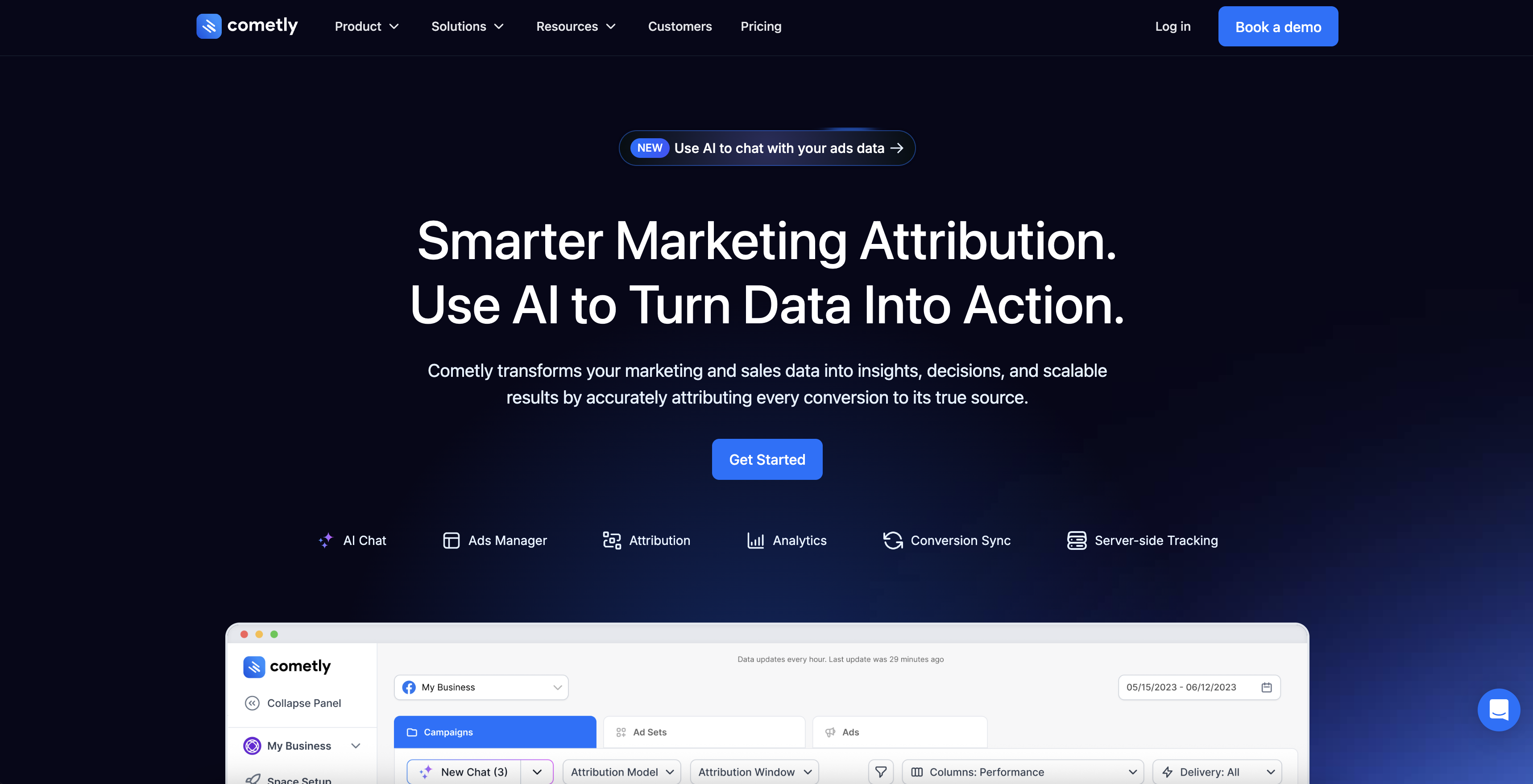
What truly distinguishes Cometly is its fusion of robust tracking with AI-driven optimization tools. Its built-in server-side tracking and one-click conversion sync are designed to combat data loss from iOS updates and browser restrictions, ensuring the data feeding into platforms like Facebook and Google Ads is as accurate as possible. This foundation of reliable data powers its AI Ads Manager, which provides real-time optimization recommendations, and its AI Chat, allowing users to query their marketing data using natural language. This combination empowers marketers to not only understand performance but also to act on insights instantly to improve ROI.
Cometly's feature set is built for scale and precision, catering to e-commerce brands, SaaS companies, and marketing agencies.
Expert Insight: For agencies managing multiple client ad accounts, Cometly streamlines the reporting and optimization process significantly. The ability to sync accurate conversion data directly back to ad platforms helps improve algorithm performance and demonstrates clear value to clients by tying ad spend directly to revenue.
Cometly does not list its pricing publicly. Prospective users need to schedule a demo to receive a custom quote tailored to their specific needs, such as data volume and the number of integrations required. This approach is common for enterprise-grade platforms and ensures the plan fits the business.
The platform emphasizes a hands-on onboarding experience, providing personalized support to ensure teams can get up and running quickly. While the feature set is extensive, this support model helps mitigate the learning curve for teams that may not have a dedicated data analyst. For those wanting to delve deeper into how such tools operate, Cometly offers resources to learn more about how ad tracking tools can help scale ads.
Best for: E-commerce brands, SaaS startups, and digital marketing agencies focused on optimizing paid ad spend with highly accurate, real-time attribution data.
Website: https://www.cometly.com
CallRail is one of the most recognized names in call tracking and a formidable WhatConverts alternative, particularly for small to mid-sized businesses and marketing agencies that prioritize ease of use and transparent pricing. It excels at connecting inbound phone calls and form submissions directly to the marketing campaigns that generated them, providing clear attribution data without a steep learning curve. The platform is built for quick implementation, allowing marketers to start gathering valuable lead data almost immediately.
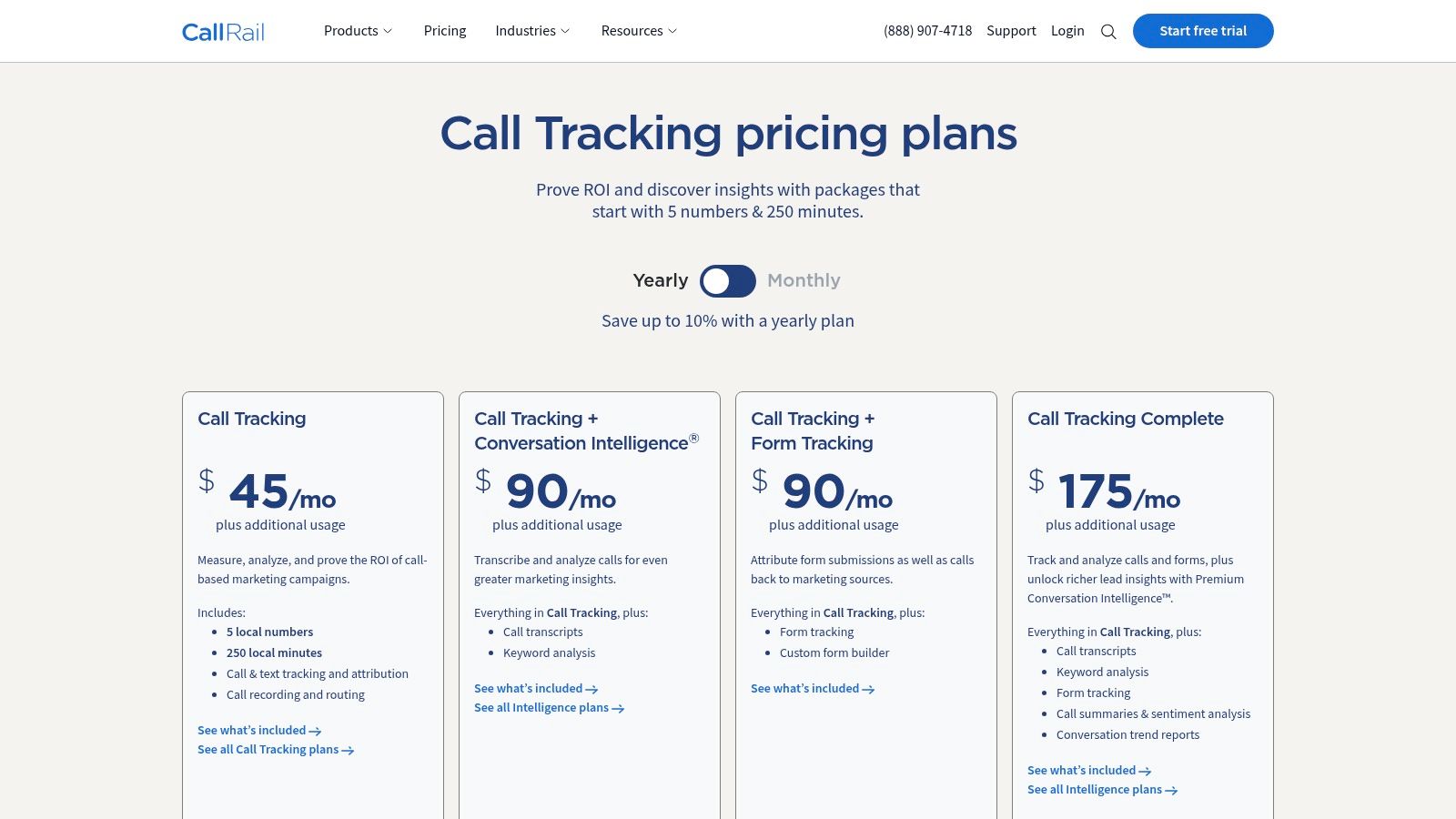
What sets CallRail apart is its straightforward plan structure. Unlike some competitors where every feature is an add-on, CallRail’s core plans bundle essential services like local numbers, call minutes, and form tracking. This makes budgeting predictable for growing businesses. Its Conversation Intelligence feature, while an add-on, uses AI to automatically transcribe calls, score leads, and identify keywords, helping teams quickly pinpoint high-value interactions without manual review.
Key Features & Use Cases
For agencies managing multiple clients, CallRail's simple onboarding and clean dashboard are significant advantages. Pricing starts with a 14-day free trial, and paid plans are structured around usage, with potential overage fees for extra minutes or numbers. This structure, while clear, may be less cost-effective for high-volume call centers compared to platforms with more customizable enterprise plans.
Website: https://www.callrail.com/pricing/
CallTrackingMetrics (CTM) positions itself as a comprehensive, all-in-one communications hub, making it a powerful WhatConverts alternative for businesses that need more than just attribution. It merges visitor-level call, form, and text tracking with a full suite of contact center tools, including a softphone, advanced routing, and chat. This unique combination allows marketing, sales, and service teams to operate within a single platform, closing the loop between lead generation and customer engagement. The platform is especially well-suited for marketing agencies and businesses in regulated industries requiring HIPAA or GDPR compliance.
What truly differentiates CTM is its scalability and automation capabilities. The platform’s open API and extensive integration library, which includes deep connections with Google Ads, HubSpot, and Salesforce, enable highly customized data flows. Features like AskAI provide automated call summaries and analysis, while trigger-based automations can score leads, update CRMs, and alert teams in real-time. This focus on automation helps businesses not only attribute conversions but also act on them instantly, making it a strategic tool for optimizing the entire customer journey. For an in-depth review, you can learn more about CallTrackingMetrics on Cometly.com.
Key Features & Use Cases
While CTM offers unlimited users on all plans, its pricing is usage-based, meaning phone numbers and minutes are billed separately. This can lead to variable costs for high-volume users. The more advanced plans are billed annually, which may require a larger upfront commitment compared to competitors with monthly options.
Website: https://www.calltrackingmetrics.com/plans-pricing/
Invoca is an enterprise-grade conversation intelligence platform positioned as a powerful WhatConverts alternative for large-scale advertisers and contact centers. It goes beyond basic call tracking, offering deep AI-driven analytics that connect pre-call digital journey data with the outcomes of phone conversations. The platform is designed for organizations with high call volumes that require sophisticated attribution, routing, and quality assurance capabilities to optimize their marketing spend and customer experience.
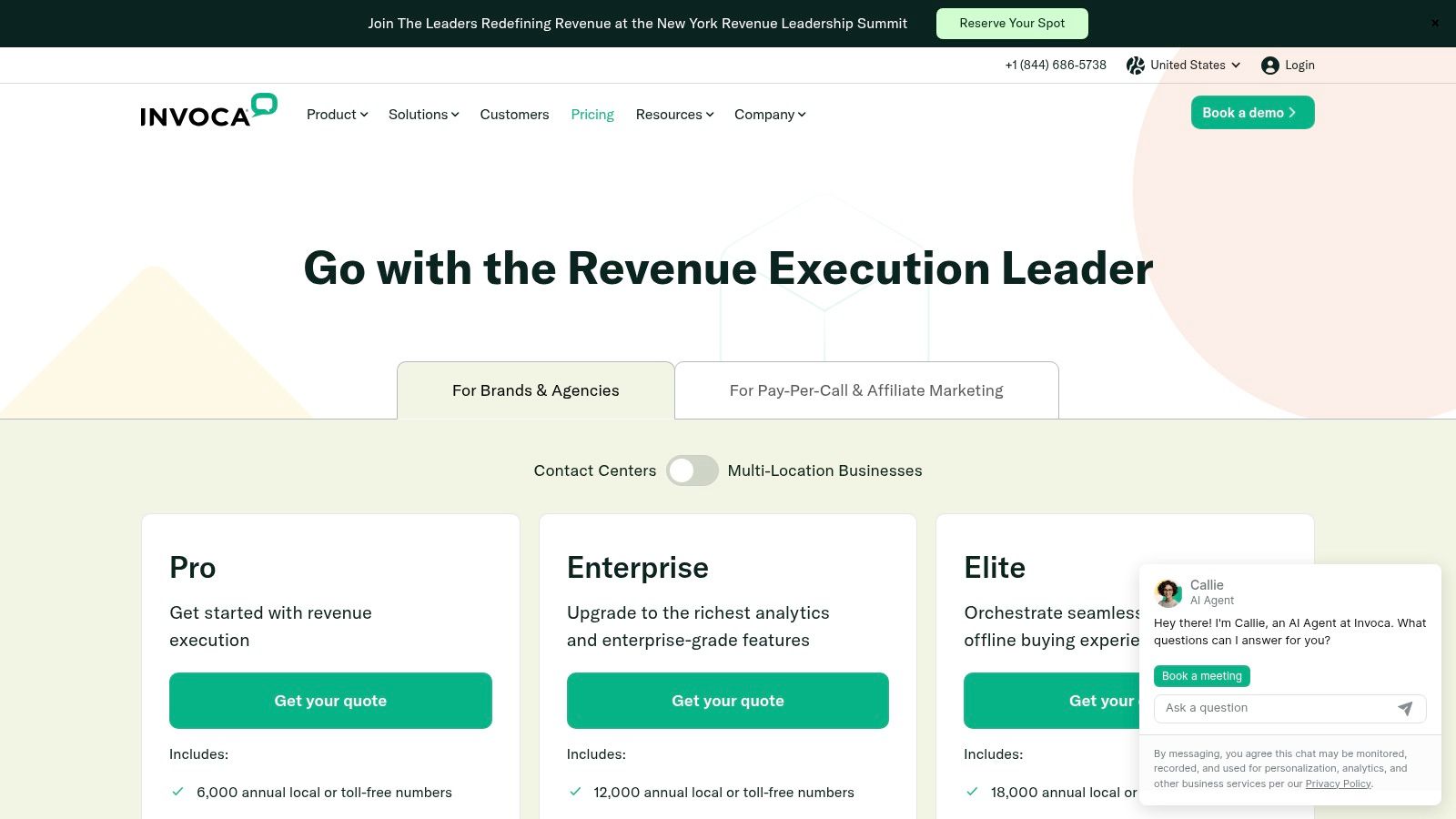
What truly distinguishes Invoca is its AI-powered analytics engine, Signal AI, which analyzes spoken conversations in real-time to identify caller intent, conversion events, and agent performance. This allows businesses to automate quality management, trigger real-time actions in their martech stack (like adding a converted caller to an ad audience), and gain a granular understanding of campaign effectiveness. This focus on enterprise-level governance, scalability, and robust integration makes it a top choice for organizations where phone calls are a critical revenue driver. For those looking to dive deeper into this topic, you can learn more about how to measure marketing attribution effectively with advanced tools.
Key Features & Use Cases
Invoca’s sophisticated feature set comes with a significant investment; pricing is available only via a custom quote and is tailored to enterprise-level budgets. This makes it overkill for small teams or businesses without substantial call volume. However, for large corporations that need proven scalability and mature integrations with platforms like Salesforce, Adobe, and Google Ads, Invoca provides unmatched depth and control.
Website: https://www.invoca.com/pricing
Infinity positions itself as a robust WhatConverts alternative for marketing, sales, and contact center teams that require deep call intelligence and a transparent, scalable pricing model. It excels at providing visitor-level call tracking and offers advanced routing capabilities typically found in enterprise-grade solutions. The platform is designed for businesses that want granular control over their call data and a clear understanding of costs, especially with its US-focused cost-per-call pricing structure.
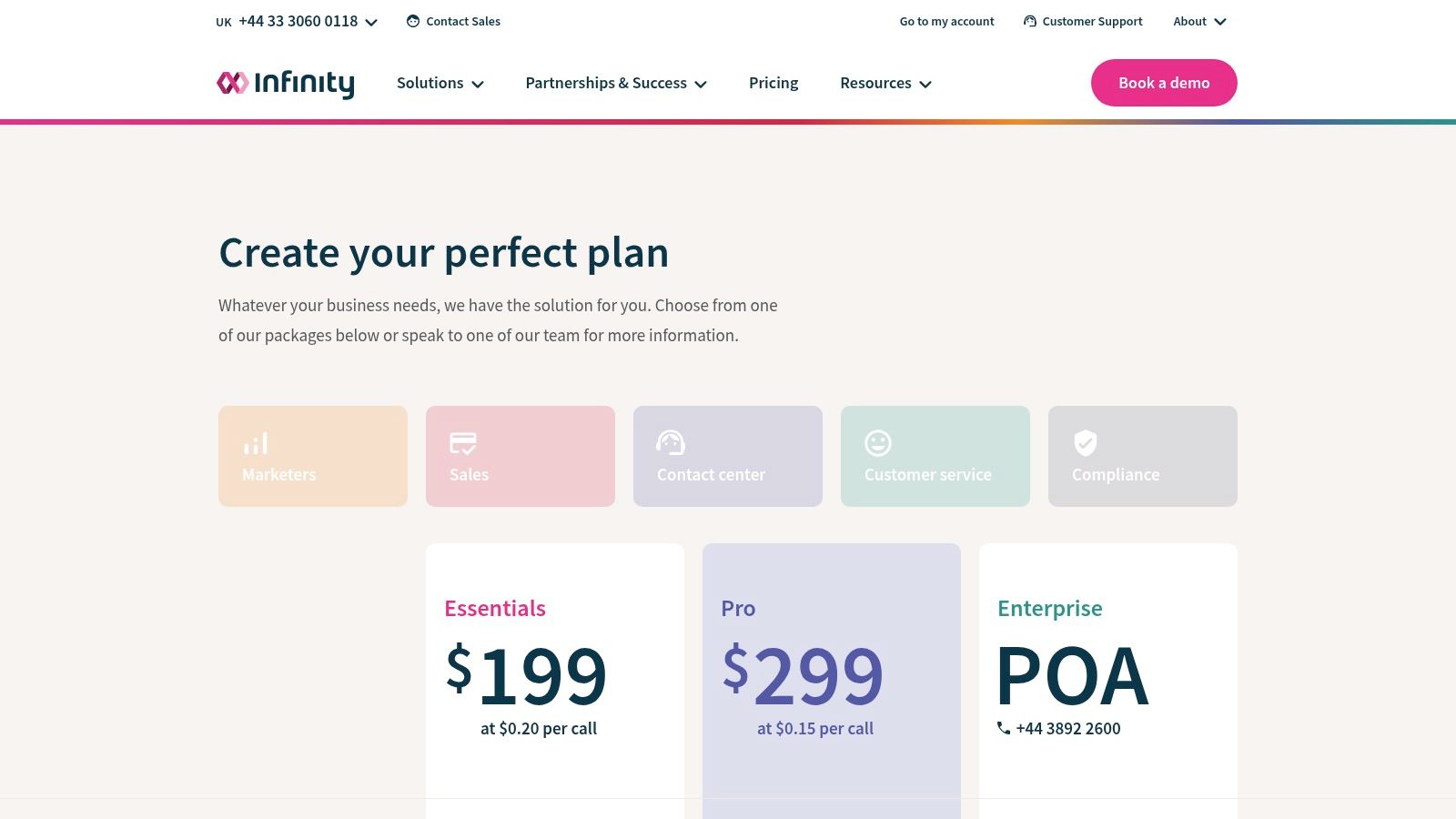
What sets Infinity apart is its commitment to both advanced features and structured support. Unlike platforms that are purely self-service, Infinity offers dedicated onboarding and VIP support options, making it suitable for larger teams that need a more hands-on implementation process. Its Pro and Enterprise plans include sophisticated Interactive Voice Response (IVR) and routing options, allowing businesses to direct calls based on marketing source, agent availability, or other custom criteria, directly improving lead management efficiency.
Key Features & Use Cases
While the transparent per-call pricing is a major advantage for budget forecasting, the mandatory 12-month minimum contract may be a barrier for smaller businesses or those seeking more flexibility. Additionally, certain features like extra data storage are billed as add-ons, which requires careful planning. Infinity is best suited for established teams ready to commit to a powerful call intelligence platform for long-term growth.
Website: https://www.infinity.co/us/pricing
Phonexa presents itself as a powerful, all-in-one marketing automation suite, making it a compelling WhatConverts alternative for businesses seeking to consolidate multiple tools under one roof. Instead of just focusing on call and form tracking, Phonexa integrates eight distinct solutions, including call tracking (Call Logic), lead distribution (LMS Sync), click tracking (Lynx), and even an integrated cloud phone system. This approach is designed for performance marketers and enterprises that manage the entire lead lifecycle, from initial click to final sale and beyond.
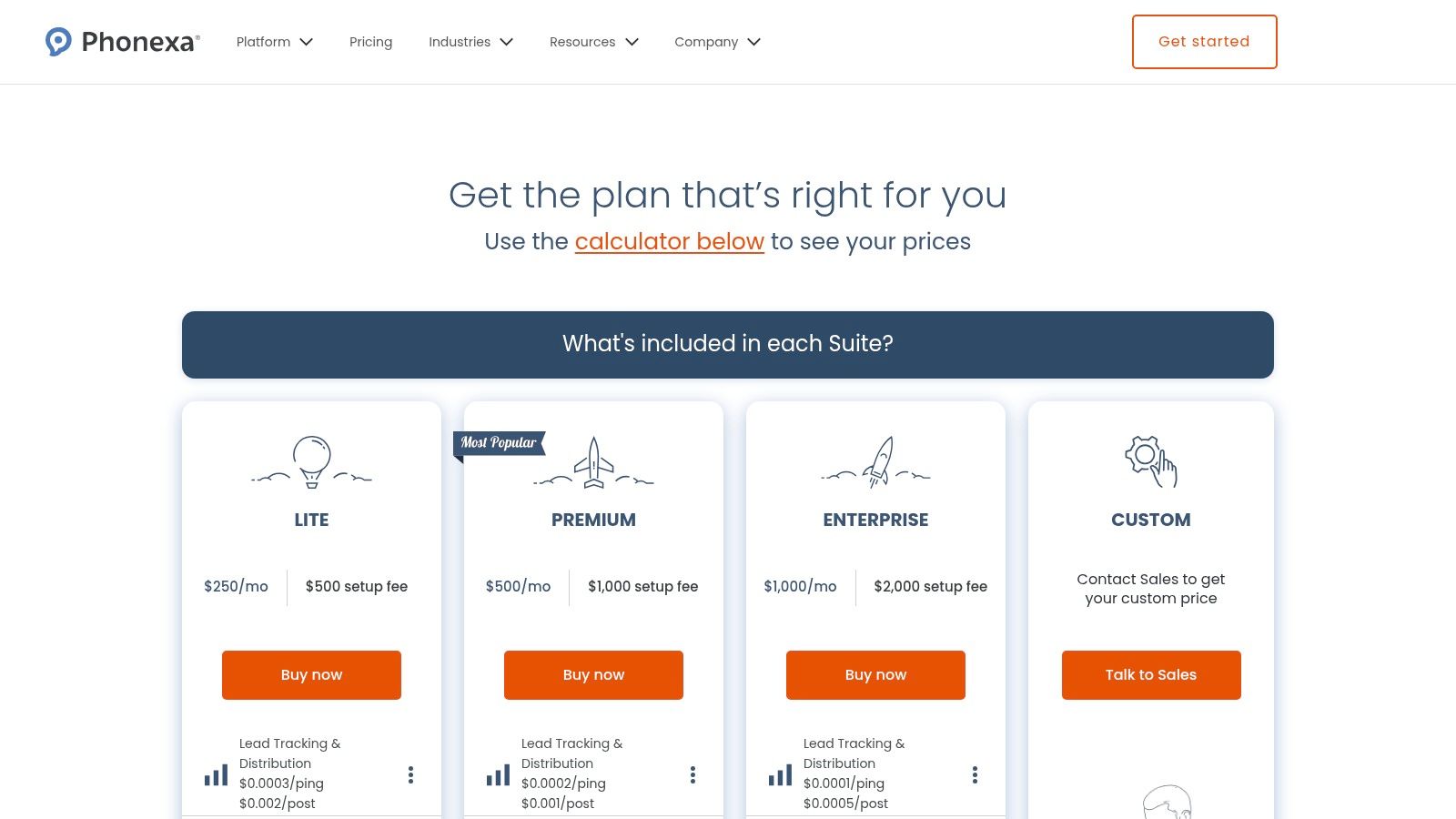
What truly makes Phonexa unique is its bundled product ecosystem. By combining various marketing technologies, it aims to eliminate data silos and reduce reliance on multiple vendors. For example, a business can track a user from their first ad click, manage their lead data if they submit a form, route their subsequent phone call to the correct agent, and then add them to an email or SMS marketing campaign, all within the same platform. This unified data stream provides a comprehensive view of customer behavior and marketing ROI.
Key Features & Use Cases
While the comprehensive feature set is a major advantage, Phonexa's complexity and pricing model may be better suited for high-volume businesses. Pricing is usage-based, with rates decreasing as volume increases, but most tiers come with a setup fee. This structure makes it ideal for companies that can leverage its full suite of tools, but potentially less cost-effective for those only needing basic call tracking.
Website: https://phonexa.com/pricing/
Convirza carves out a specific niche as a WhatConverts alternative by blending traditional call tracking with a heavy focus on conversation analytics for sales and service team coaching. It's an excellent choice for businesses that not only want to attribute calls to marketing efforts but also want to analyze and improve the quality of those conversations. The platform is designed for teams that prioritize agent performance and quality assurance, making it more than just a marketing attribution tool.
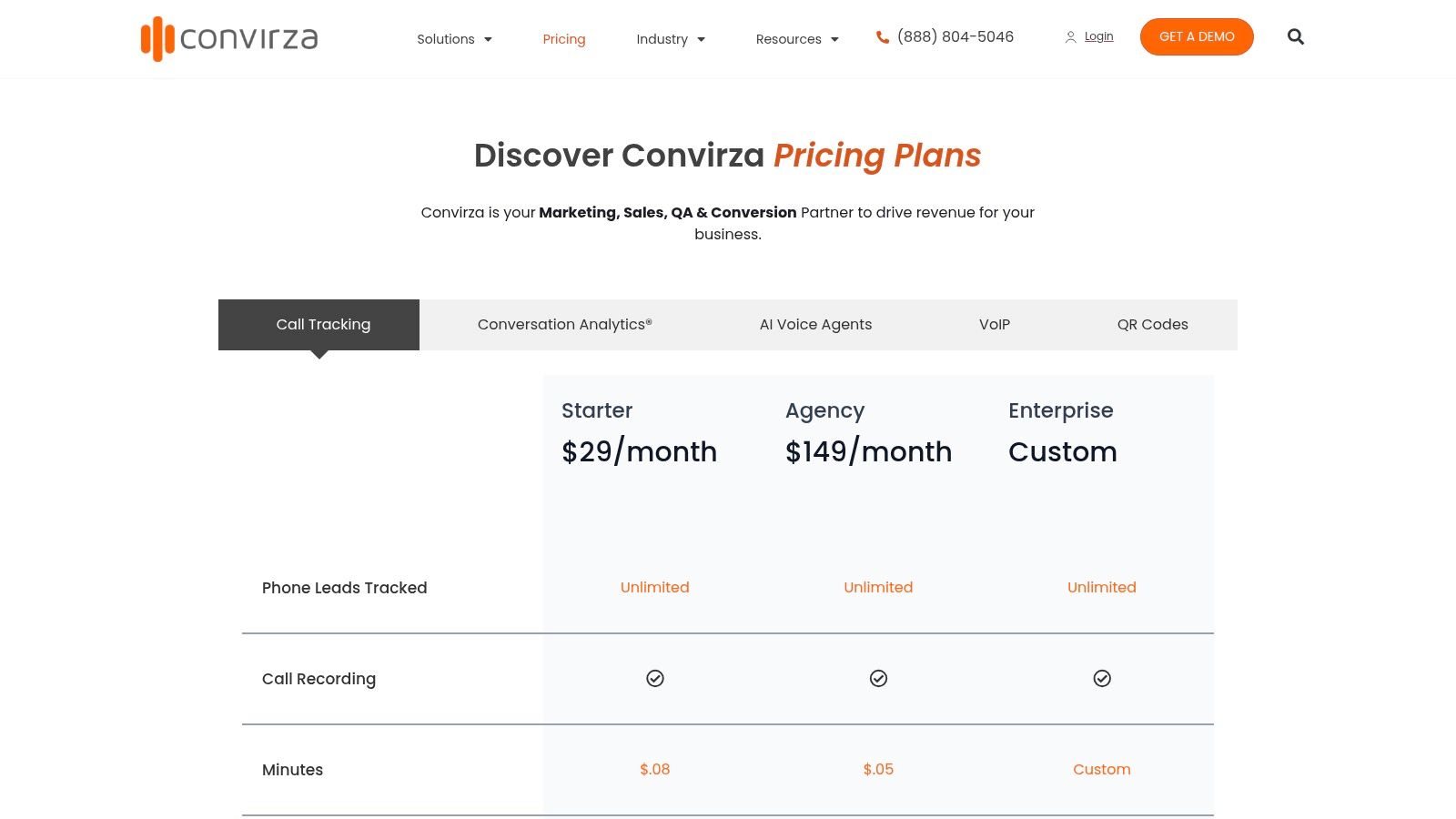
What makes Convirza stand out is its emphasis on AI-driven conversation intelligence, specifically for coaching. The platform generates scorecards, transcripts, and summaries designed to provide actionable revenue insights and identify training opportunities. This makes it particularly valuable for sales managers and QA teams. Its attractive entry-level pricing and agency-friendly plans offer a cost-effective way for smaller US-based teams to access sophisticated call analytics features without the enterprise-level price tag.
Key Features & Use Cases
While Convirza's purpose-built coaching tools are a significant strength, its user interface and overall feature set may feel less expansive when compared to top-tier enterprise solutions. Some advanced capabilities are locked behind higher-tier plans or require add-ons. However, for organizations focused on improving sales effectiveness through call analysis, Convirza offers a compelling and affordable solution.
Website: https://www.convirza.com/pricing/
Ringba is a powerful WhatConverts alternative tailored for the performance marketing and pay-per-call industry. It moves beyond standard attribution to provide a sophisticated platform for call routing, real-time bidding, and managing publisher-buyer relationships. For businesses where inbound calls are a monetizable asset, Ringba offers unparalleled control and scalability, making it ideal for affiliate networks, lead generation agencies, and high-volume call centers.
What truly distinguishes Ringba is its infrastructure built for performance. Its platform is engineered for real-time data processing and complex call flow management, allowing users to optimize campaigns for maximum profitability, not just attribution. While WhatConverts focuses on connecting marketing efforts to leads for a single business, Ringba provides the tools to build and manage an entire call marketplace, complete with publisher payouts and dynamic routing based on buyer demand.
Key Features & Use Cases
Ringba's transparent, no-contract pricing is highly competitive, scaling from individual marketers to large enterprises. However, its advanced feature set may present a steeper learning curve for users accustomed to simpler attribution tools. For those diving into performance marketing analytics, it’s a robust platform worth exploring. Understanding its place in the broader ecosystem of marketing analytics software helps clarify its unique value.
Website: https://wp-origin.ringba.com/pricing
Retreaver is a highly flexible call tracking platform and a specialized WhatConverts alternative designed for performance marketers, affiliate networks, and pay-per-call campaigns. It excels where granular control over call routing and data passing is paramount. The platform is engineered to handle complex attribution scenarios, allowing users to tag calls with rich, real-time data and route them based on custom logic, making it ideal for high-volume lead generation.

What truly sets Retreaver apart is its focus on the pay-per-call ecosystem. It provides robust tools for managing publishers, tracking conversions, and calculating payouts, which are often secondary features in more generalized platforms. Its powerful API and webhook capabilities allow for deep integration into existing workflows and CRM systems. This makes it a strong contender for tech-savvy marketing teams that need to build custom attribution models or operate in compliance-sensitive industries like finance or healthcare.
Key Features & Use Cases
While its powerful feature set is a major draw for performance marketers, the platform’s pricing is not publicly listed and requires a sales consultation. This may be a hurdle for smaller businesses looking for transparent, predictable costs. However, its self-serve account creation and occasional starter credit promotions make it accessible for those wanting to test its advanced capabilities.
Website: https://retreaver.com/call-tracking
HubSpot presents a unique proposition as a WhatConverts alternative by integrating VoIP calling directly into its robust CRM platform. While not a standalone marketing attribution tool in the traditional sense, its native calling features are ideal for businesses already embedded in the HubSpot ecosystem. This approach consolidates sales and service communications, linking every call directly to a contact record, deal, or ticket, which streamlines activity logging and follow-up.

What sets HubSpot apart is its focus on operational efficiency rather than granular, session-based call attribution. Instead of using DNI to track ad sources, it excels at managing and analyzing conversations with known leads and customers. Higher tiers of Sales and Service Hub unlock call transcription and AI-powered intelligence, providing insights into conversation quality and agent performance. This makes it a powerful choice for teams that prioritize a single source of truth for all customer interactions. Learn more about top HubSpot Marketing Attribution alternatives.
Key Features & Use Cases
For businesses looking to reduce tool sprawl and unify their sales, marketing, and service stacks, HubSpot’s built-in calling is an excellent solution. While its native capabilities are not designed for top-of-funnel marketing attribution, its powerful integration options mean it can easily serve as the central hub for data from specialized marketing attribution tools. The number of calling minutes and phone numbers are limited by subscription tier, which is a key consideration for high-volume teams.
Website: https://www.hubspot.com/products/voip
For organizations with access to developer resources, Twilio represents the ultimate "build-it-yourself" WhatConverts alternative. It is not a turnkey call tracking platform but rather a powerful communications API that provides the fundamental building blocks for creating a completely custom attribution system. This approach offers unparalleled flexibility, allowing businesses to design workflows, data structures, and reporting dashboards that are perfectly tailored to their unique operational needs.
Twilio stands apart by giving you full control over the entire call lifecycle. Instead of being confined to a pre-built interface, your team can use Twilio’s extensive APIs to programmatically purchase phone numbers, route calls, record conversations, and push data into any analytics tool or CRM. This is ideal for companies with complex routing requirements, specific compliance needs, or those wanting to integrate call data deeply into proprietary software.
Key Features & Use Cases
The primary trade-off is the significant engineering investment required to replicate the out-of-the-box features of a platform like WhatConverts, such as Dynamic Number Insertion (DNI) or a user-friendly reporting dashboard. Twilio is best suited for tech-savvy marketing teams or enterprises that prioritize customization and scalability over speed of implementation and have the technical talent to build and maintain the system.
Website: https://www.twilio.com/en-us/sms/pricing/us
For those in the initial research phase, G2’s curated comparison page is a powerful starting point. It’s not a direct competitor but a meta-resource that aggregates real user reviews, ratings, and feature checklists for dozens of WhatConverts alternative platforms. This makes it an invaluable tool for shortlisting potential solutions based on unbiased peer feedback and specific business needs, such as company size or industry focus.
What makes G2 particularly useful is its granular filtering system. Users can sift through options based on critical features like Dynamic Number Insertion (DNI), keyword-level tracking, or specific integrations. This allows you to quickly narrow down a vast market to a handful of tools that meet your core requirements. The platform consolidates user-submitted pros and cons, providing a balanced view that cuts through marketing hype and highlights real-world performance and limitations.
Key Features & Use Cases
While G2 is an excellent research hub, it's important to remember that some platform rankings may be influenced by vendor relationships, and pricing information can sometimes be outdated. Always verify details directly on the vendor's site. However, for building a data-driven shortlist and validating claims, G2 provides a comprehensive and efficient overview of the competitive landscape.
Website: https://www.g2.com/products/whatconverts/competitors/alternatives
Navigating the landscape of call tracking and marketing attribution tools can feel overwhelming. After exploring a dozen distinct options, it's clear that while WhatConverts provides a solid foundation, the "best" alternative truly depends on your specific business goals, operational scale, and technical capabilities. The right WhatConverts alternative isn't just about replacing one dashboard with another; it's about upgrading your data intelligence to drive more profitable decisions.
This article has detailed everything from enterprise-grade AI-powered conversation intelligence with Invoca and Infinity to highly specialized, usage-based platforms for performance marketers like Ringba and Retreaver. We've also seen all-in-one solutions like CallRail and CallTrackingMetrics that serve a broad SMB and agency audience, alongside the developer-centric approach of Twilio. The key takeaway is that the market has evolved beyond simple call and form tracking. The most advanced solutions now connect every marketing touchpoint directly to sales revenue, providing a complete picture of your customer journey.
To help synthesize this information, here is a summary table comparing the tools we've discussed across crucial decision-making criteria. Use this as a quick-reference guide to narrow down your top contenders based on what matters most to your organization.
Before you sign up for a demo or free trial, ask yourself these four fundamental questions. Your answers will illuminate the path to the perfect solution for your needs.
Ultimately, choosing a WhatConverts alternative is a strategic decision. While many tools can tell you where a call came from, the most valuable platforms tell you which marketing efforts are actually generating revenue. For modern marketers, the goal has shifted from tracking leads to tracking profit. Solutions like Cometly are at the forefront of this evolution, offering a more future-proof approach by focusing on what truly matters: comprehensive, multi-touch revenue attribution.
Ready to move beyond basic call tracking and unlock true, end-to-end marketing attribution? Cometly is designed for data-driven marketers who need to connect every ad dollar directly to sales revenue, providing clarity where other tools fall short. See for yourself how top brands are optimizing their ad spend with precision by exploring Cometly today.
Learn how Cometly can help you pinpoint channels driving revenue.
.svg)
Network with the top performance marketers in the industry